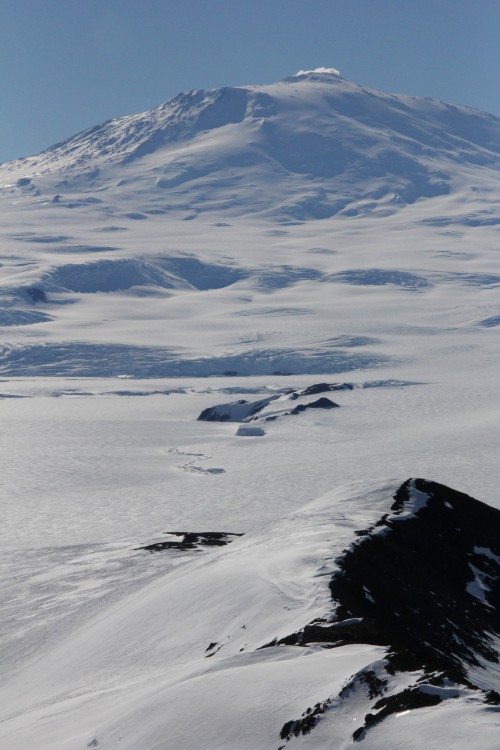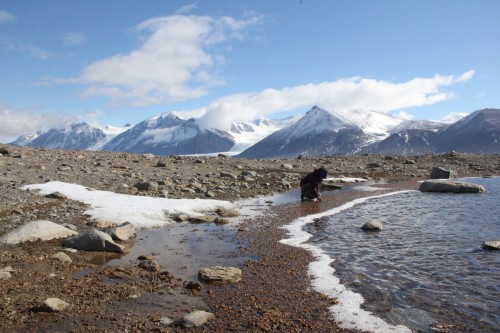By the time this blog is posted, we’ll be somewhere over the Southern Ocean, heading toward Christchurch, New Zealand. We’ve had an incredible month here in Antarctica, and it’s been wonderful to share our experiences with you all. Here’s one final blog answering more questions from the students in Windsor, VT. Many thanks to the students who asked such great questions – you have made us think about our experiences from new perspectives. We can’t wait to meet you sometime this spring!
- How are Antarctica’s Dry Valleys desert similar and different to warm climate deserts here in the US?
It can be surprising to learn that Antarctica is a huge desert, since warm deserts (like in the Southwest US) tend to come first to people’s minds. Although the two landscapes may look very different, there are actually a lot of similarities. For instance, think about the organisms that survive in these harsh environments. Desert organisms need to be able to cope with long periods of time with no liquid water, and they need to immediately take advantage of the water when it returns. In both warm and cold climates, organisms deal with this challenge in similar ways by entering a state called cryptobiosis, which allows them to live indefinitely when conditions are unfavorable. Cryptobiosis is an adaptation that allows organisms in both cold and warm deserts to survive.

Tardigrades, or water bears, seen here through a microscope, are experts at entering cryptobiosis.
Of course, there are many differences between the Dry Valleys and the Southwestern US. One big difference has to do with where liquid water comes from. In the Dry Valleys, the majority of the liquid water running through streams comes from glacier melt during the warm summer months, which is not the case in the Southwest. What do you think might happen to the Dry Valley landscape as the climate warms?

The majority of the liquid water in the Dry Valleys comes from melting glaciers. Here, Taylor Glacier drips in the beaming sun.
- Is the Commonwealth Glacier, or any glacier different from an ice sheet? What is the thinnest depth of the 1+ mile thick ice sheet?
Yes, glaciers are different from ice sheets! Mostly, it’s a matter of scale. Ice sheets are enormous. There is so much ice that at the top of an ice sheet, all you can see in any direction is a flat white expanse. At the center of an ice sheet, the underlying land surface – the mountains and valleys that would be exposed if there were no ice – doesn’t influence the direction of ice flow. Ice flows out in all directions from the thickest point of the ice sheet, regardless of what’s beneath it. At the edges of an ice sheet, however, there can be areas that are very thin, and mountains can even poke up through the ice.

Although the Taylor Glaciers flows out of a huge ice sheet, it is a valley glacier, since it is confined to the valley between towering mountains.
Valley glaciers, like the Commonwealth Glacier, are much smaller than ice sheets. Valley glaciers, as the name implies, are confined to the space between two mountains, so the local topography is very important in determining where the ice flows. The Commonwealth Glacier is a beautiful example of a valley glacier – it’s narrow between two mountains, and then expands as it reaches the floor of Taylor Valley.
- In the photo with your tent, how far away is your tent from the Commonwealth Glacier? Also, how far are you from the mountain in the background?
Our tents at F6 Camp are about 1.5 miles away from the Commonwealth Glacier, if we were to take the shortest route. The camp is about 7 to 8 miles away from the tallest mountains you can see in the photo. In order to answer your questions, I had to measure the distances on a map. Scale is really hard to judge in Antarctica. With no trees or buildings, it’s almost impossible to tell how far away something is.

Distances and elevations can be very deceiving in Antarctica. Mount Erebus, the southernmost active volcano, seems so close to McMurdo. In reality, it’s almost 30 miles away and is 12,500 feet tall! I would never guess that by looking at this photo!
- Do you take water samples along with soil samples? Do you take soil samples under water?
Great questions! Although I’m focused on collecting soil samples, Jess and many other scientists working in the Dry Valleys collect water samples from streams, ponds, and lakes. They analyze these samples to see what organisms live in the water and to determine the nutrients and other chemicals in the water. So yes, we definitely collect water samples.

Jess collects water samples from one of the many ponds in Taylor Valley.
We also collect samples of soils from within the streams. The majority of the soils in the Dry Valleys are very dry, located far away from any body of water. The wet soils near the streams, however, can be very different from the dry soils elsewhere. For instance, we find one particular species of nematode (microscopic worms) that really likes the wet soil, while another species prefers the drier habitats. Finally, other scientists have also collected sediment from beneath the lakes of the Dry Valleys. These lake sediments are really cool because they can be really old, allowing us to determine what the lake was like hundreds and thousands of years ago.
- Do you need tools to get across wide streams or do you have a plan B?
Having a plan B is always a good idea in Antarctica, where things never go quite according to plan. However, we have easily been able to cross the streams this season in just our hiking boots, since most of the streams are very shallow. A more difficult water crossing is getting onto the lake ice from the shore, across the moat that develops every summer. To get across the moat, people use ladders, planks of wood, and sometimes boats. Just in case, we always carry lots of extra layers, so that we can quickly get dry if we do get wet.

During the summer months, a moat forms between the shore and the lake ice. Scientists crossing the moat to get out onto the lake ice will definitely want to have a Plan B!
- Do you get to access a helicopter whenever you need it & what type of helicopter is it?
Flying in helicopters is one of our favorite aspects of working in the Dry Valleys. It’s absolutely spectacular to see the mountains and glaciers from the air. We’re incredibly lucky to have access to helicopter support – without it we wouldn’t be able to do our work. We share access to the helicopters with a lot of other people, so there are a lot of steps we have to go through before the helicopter can take us to where we want to go. Three days before we want to travel, we have to fill out a helicopter request form, saying where we want to go, and how long we want to be there. If all goes well, the night before we travel, we’ll get the helicopter schedule, telling us when we’ll be flying and which helicopter we’ll be on. Of course, as with everything in Antarctica, the schedule can quickly change due to weather, mechanical issues, or something else unexpected.

An AStar approaches F6 Camp after a few days of snowy weather prevented all helicopter travel in the valley.
There are two types of helicopters down here, and we’ve flown in both. The bigger helicopter is a Bell-212, which can seat the pilot, the helicopter tech, and 8 passengers in the back. The Bell-212 can carry a lot of weight compared to the smaller helicopter, the AStar. The AStar can fit the pilot and usually just three to four passengers. Both are fun to fly in, but it’s definitely exciting to be in the front seat of the AStar because the windows go down around your feet and the views are incredible.

A Bell-212 is refueled before taking off to take us back to McMurdo.
Many thanks again to all the students for asking such interesting and thoughtful questions!
Read Full Post »














